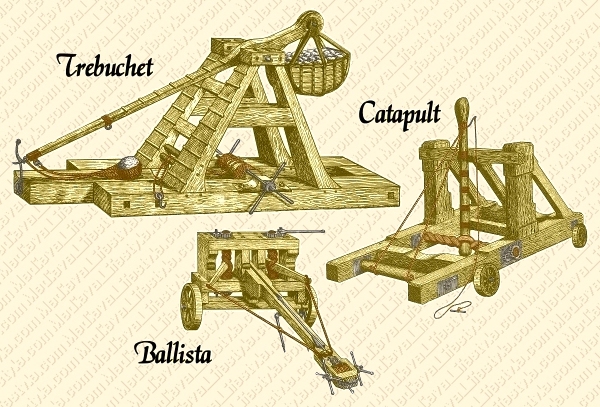Siege Engines: Medieval Mechanical Mayhem

Siege Engines were the heavy artillery of the Middle Ages, and because of their amazing power these great mechanical contrivances hold tremendous fascination for us in this age of technological warfare. These ancient weapons are a tribute to man’s ingenuity and imagination, and they respectfully remind us of the conflict and brutality inherent in humankind.
There exists endless scholarly bickering over the naming, classification, and dating of medieval artillery; therefore, we have tried to stick to the generally accepted characteristics of the "big three" as they evolved — the Ballista, the Catapult, and the mighty Trebuchet.
Dionysius' Think-Tank
There is little written historical evidence concerning the use of siege artillery in warfare before about 400 b.c. Part of the reason that we start to hear much more about siege weapons after this time is due to a conference organized by one Dionysius the First, ruler of the powerful city of Syracuse in Sicily.
At this time in history the Greek cities of Athens and Sparta were the focal points of clashing ideologies. Allies of both were constantly engaged in bloody power struggles via:
pitched battles (scheduled encounters),
skirmishes (unscheduled battles), or
sieges (attack of a fortress or town).
Dionysius, seeking to possess the best weaponry, lured the finest engineers, scientists, and mathemeticians of the day to Syracuse in 399 b.c. to meet and develop new technologies. High wages and valuable prizes were offered to participants, and revolutionary new concepts and inventions appeared in weapons technology.
Dionysius' conference spawned a century of rapid technological advancement in weaponry, and sometime during this period the torsion spring was invented (see siege engine mechanics). This invention was the most important advancement in siege weapon technology to date and gave rise to the ballista and the torsion catapult.
The Ballista
One of the earliest forms of artillery, the Ballista (also, Balista) was first utilized in siege warfare between 300 and 400 b.c. It was to become primarily a bolt-thrower, although its evolution included the launching of stones.
The Ballista was the smallest and most maneuverable of the three engines and found an important place in sieges for over a thousand years. This weapon utilized two torsion springs (for details see Siege Engine Mechanics) and two throwing arms to launch its payload along a center track.
More Information on the Ballista
The Catapult
Larger than the Ballista, the Catapult featured a single throwing arm which, when winched back and released, tossed a boulder or other imaginative payload conveniently into the dreading arms of the enemy.
The Catapult also employed a torsion spring (for details see Siege Engine Mechanics). Batteries of catapults were assigned to hammer away at the stone walls of medieval fortifications.
More Information on the Catapult
The Trebuchet
The latest siege engine of the three to be deployed and the largest, the massive trebuchet was a deadly demonstration of what a simple mechanical lever can accomplish. The machine undoubtedly evolved from a type of traction catapult (for details see Siege Engine Mechanics).
The Trebuchet’s throwing arm, often engineered on site from a large tree trunk, harnessed the power of gravity dropping heavy loads of stone or lead which would in turn propel a large sling on the opposite end of the arm through a powerful arc, sending even bigger boulders over greater distances to torment the unfortunate target.
More Information on the Trebuchet
Nasty Payloads
Siege weapons launched bolts, stones, and boulders, but they were also used in more imaginative ways to psychologically demoralize the enemy. Among the payloads employed might have been a nice basket of poisonous snakes, a hornets nest, or a beehive. Such payloads became effectively more irritable upon arrival.
When stuck behind the castle walls, nowhere to go, a continued bombardment with manure and animal carcasses did little for morale and encouraged the spread of disease.
If the messenger sent to negotiate with the attackers received a less-than-cordial welcome, he might be forced to take a pre-Wright-Brothers flight home. Perhaps the ultimate demoralizer would be to have the garrison's fallen soldiers likewise returned.
Greek Fire
As if hurling boulders and carcasses weren't effective enough, siege weapons would also be armed with wads of actively burning materials to be repeatedly heaved upon the opponent. Troops were kept busy dousing fires, using up their precious water supplies.
A payload later evolved known as “Greek Fire,” an invention of Kallinikos (or Callinicus), a Syrian Christian architect/alchemist who expatriated to Constantinople in the 7th century A.D. This gelatinous adhesive substance composed of oils and resins could not be extinguished with water. It would even burn upon the surface of the sea, making it especially effective in maritime combat.
Among the only effective ways to put out Greek Fire was saturating — and resaturating — combustible structures with stale urine that troops had been donating for weeks in anticipation of the battle.
The exact formula for Greek Fire was guarded so well that it was lost to history, and siege artillery provided but one of several methods for delivering this ancient napalm. But the effectiveness of Greek Fire led to changes in fortress design and inspired the emergence of numerous other incendiary cocktails.
See Medieval Castles for more information on castle sieges.